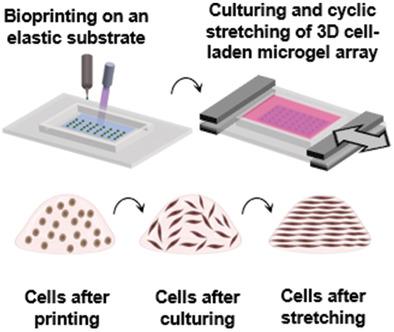Our official English website, www.x-mol.net, welcomes your
feedback! (Note: you will need to create a separate account there.)
High Throughput Screening of Cell Mechanical Response Using a Stretchable 3D Cellular Microarray Platform.
Small ( IF 13.0 ) Pub Date : 2020-06-26 , DOI: 10.1002/smll.202000941 Kabilan Sakthivel 1 , Hitendra Kumar 1 , Mohamed G A Mohamed 1 , Bahram Talebjedi 1 , Justin Shim 1 , Homayoun Najjaran 1 , Mina Hoorfar 1 , Keekyoung Kim 1, 2, 3
Small ( IF 13.0 ) Pub Date : 2020-06-26 , DOI: 10.1002/smll.202000941 Kabilan Sakthivel 1 , Hitendra Kumar 1 , Mohamed G A Mohamed 1 , Bahram Talebjedi 1 , Justin Shim 1 , Homayoun Najjaran 1 , Mina Hoorfar 1 , Keekyoung Kim 1, 2, 3
Affiliation

|
Cells in vivo are constantly subjected to multiple microenvironmental mechanical stimuli that regulate cell function. Although 2D cell responses to the mechanical stimulation have been established, these methods lack relevance as physiological cell microenvironments are in 3D. Moreover, the existing platforms developed for studying the cell responses to mechanical cues in 3D either offer low‐throughput, involve complex fabrication, or do not allow combinatorial analysis of multiple cues. Considering this, a stretchable high‐throughput (HT) 3D cell microarray platform is presented that can apply dynamic mechanical strain to cells encapsulated in arrayed 3D microgels. The platform uses inkjet‐bioprinting technique for printing cell‐laden gelatin methacrylate (GelMA) microgel array on an elastic composite substrate that is periodically stretched. The developed platform is highly biocompatible and transfers the applied strain from the stretched substrate to the cells. The HT analysis is conducted to analyze cell mechano‐responses throughout the printed microgel array. Also, the combinatorial analysis of distinct cell behaviors is conducted for different GelMA microenvironmental stiffnesses in addition to the dynamic stretch. Considering its throughput and flexibility, the developed platform can readily be scaled up to introduce a wide range of microenvironmental cues and to screen the cell responses in a HT way.
中文翻译:

使用可拉伸3D细胞微阵列平台的细胞机械反应的高通量筛选。
体内细胞不断受到多种调节细胞功能的微环境机械刺激。尽管已经建立了2D细胞对机械刺激的反应,但是由于3D生理细胞微环境,这些方法缺乏相关性。而且,为研究细胞对3D机械提示的响应而开发的现有平台要么提供低通量,复杂的制造过程,要么不允许对多个提示进行组合分析。考虑到这一点,提出了一种可拉伸的高通量(HT)3D细胞微阵列平台,该平台可以对封装在阵列3D微凝胶中的细胞施加动态机械应变。该平台使用喷墨生物打印技术在周期性拉伸的弹性复合材料基底上印刷载有细胞的甲基丙烯酸明胶(GelMA)微凝胶阵列。开发的平台具有高度的生物相容性,可将施加的应变从拉伸的底物转移至细胞。进行HT分析以分析整个印刷的微凝胶阵列中的细胞机械反应。此外,除了动态拉伸外,还针对不同的GelMA微环境刚度进行了不同细胞行为的组合分析。考虑到其吞吐量和灵活性,可以轻松扩展已开发的平台,以引入各种微环境线索并以HT方式筛选细胞反应。除了动态拉伸外,还针对不同的GelMA微环境刚度进行了不同细胞行为的组合分析。考虑到其吞吐量和灵活性,可以轻松扩展已开发的平台,以引入各种微环境线索并以HT方式筛选细胞反应。除了动态拉伸外,还针对不同的GelMA微环境刚度进行了不同细胞行为的组合分析。考虑到其吞吐量和灵活性,可以轻松扩展已开发的平台,以引入各种微环境线索并以HT方式筛选细胞反应。
更新日期:2020-07-28
中文翻译:

使用可拉伸3D细胞微阵列平台的细胞机械反应的高通量筛选。
体内细胞不断受到多种调节细胞功能的微环境机械刺激。尽管已经建立了2D细胞对机械刺激的反应,但是由于3D生理细胞微环境,这些方法缺乏相关性。而且,为研究细胞对3D机械提示的响应而开发的现有平台要么提供低通量,复杂的制造过程,要么不允许对多个提示进行组合分析。考虑到这一点,提出了一种可拉伸的高通量(HT)3D细胞微阵列平台,该平台可以对封装在阵列3D微凝胶中的细胞施加动态机械应变。该平台使用喷墨生物打印技术在周期性拉伸的弹性复合材料基底上印刷载有细胞的甲基丙烯酸明胶(GelMA)微凝胶阵列。开发的平台具有高度的生物相容性,可将施加的应变从拉伸的底物转移至细胞。进行HT分析以分析整个印刷的微凝胶阵列中的细胞机械反应。此外,除了动态拉伸外,还针对不同的GelMA微环境刚度进行了不同细胞行为的组合分析。考虑到其吞吐量和灵活性,可以轻松扩展已开发的平台,以引入各种微环境线索并以HT方式筛选细胞反应。除了动态拉伸外,还针对不同的GelMA微环境刚度进行了不同细胞行为的组合分析。考虑到其吞吐量和灵活性,可以轻松扩展已开发的平台,以引入各种微环境线索并以HT方式筛选细胞反应。除了动态拉伸外,还针对不同的GelMA微环境刚度进行了不同细胞行为的组合分析。考虑到其吞吐量和灵活性,可以轻松扩展已开发的平台,以引入各种微环境线索并以HT方式筛选细胞反应。











































 京公网安备 11010802027423号
京公网安备 11010802027423号